饮冰三年-人工智能-Python-20 Python线程、进程、线程
进程:最小的数据单元
线程:最小的执行单元
一:
1:线程1
- import threading #线程
- import time
- def Music():
- print("Listen Music Begin %s" %time.ctime())
- time.sleep()
- print("Listen Music End %s" %time.ctime())
- def Game():
- print("Play Game Begin %s" %time.ctime())
- time.sleep()
- print("Play Game End %s" %time.ctime())
- if __name__ == '__main__':
- t1 = threading.Thread(target=Music)
- t1.start()
- t2 = threading.Thread(target=Game)
- t2.start()
- print("ending......")
实例1

- import threading #线程
- import time
- def Music():
- print("Listen Music Begin %s" %time.ctime())
- time.sleep(3)
- print("Listen Music End %s" %time.ctime())
- def Game():
- print("Play Game Begin %s" %time.ctime())
- time.sleep(5)
- print("Play Game End %s" %time.ctime())
- if __name__ == '__main__':
- t1 = threading.Thread(target=Music)
- t1.start()
- t2 = threading.Thread(target=Game)
- t2.start()
- t1.join()
- t2.join()
- print("ending......")
线程join
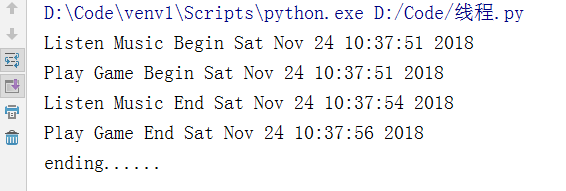
- import threading #线程
- import time
- def Music(musicName):
- print("Listen Music【%s】 Begin %s" %(musicName,time.ctime()))
- time.sleep(3)
- print("Listen Music【%s】 End %s" %(musicName,time.ctime()))
- def Game(playName):
- print("Play Game【%s】 Begin %s" %(playName,time.ctime()))
- time.sleep(5)
- print("Play Game【%s】 End %s" %(playName,time.ctime()))
- if __name__ == '__main__':
- t1 = threading.Thread(target=Music,args=("My Heart Will Go On",))
- t2 = threading.Thread(target=Game,args=("植物大战僵尸",))
- threads=[]
- threads.append(t1)
- threads.append(t2)
- for t in threads:
- t.start();
- print("ending......")
线程参数

- import threading #线程
- import time
- def Music(musicName):
- print("Listen Music【%s】 Begin %s" %(musicName,time.ctime()))
- time.sleep(3)
- print("Listen Music【%s】 End %s" %(musicName,time.ctime()))
- def Game(playName):
- print("Play Game【%s】 Begin %s" %(playName,time.ctime()))
- time.sleep(5)
- print("Play Game【%s】 End %s" %(playName,time.ctime()))
- t1 = threading.Thread(target=Music,args=("My Heart Will Go On",))
- t2 = threading.Thread(target=Game,args=("植物大战僵尸",))
- threads=[]
- threads.append(t1)
- threads.append(t2)
- if __name__ == '__main__':
- t2.setDaemon(True)
- for t in threads:
- t.start();
- print("ending......")
守护线程

- # 多线程为什么要使用锁?
- # 多线程共用一个数据集,不使用可能会造成数据不准确
- #1:引入多线程模块
- import threading
- import time
- # 2:定义一个变量(数据集)
- num=100
- # 3:定义一个方法,操作全局变量
- def sub():
- global num
- temp = num
- time.sleep(0.001)
- num=temp-1
- # 4:创建多个线程
- ts=[]
- for i in range(0,100):
- t=threading.Thread(target=sub)
- t.start()
- ts.append(t)
- for t in ts:
- t.join()
- print(num)
未加锁,数据结果有误

- # 多线程为什么要使用锁?
- # 多线程共用一个数据集,不使用可能会造成数据不准确
- #1:引入多线程模块
- import threading
- import time
- # 2:定义一个变量(数据集)
- num=100
- # 3:定义一个方法,操作全局变量
- # 5:创建锁
- lock=threading.Lock()
- def sub():
- global num
- # 5.1 加锁
- lock.acquire()
- temp = num
- time.sleep(0.001)
- num=temp-1
- # 5.2 释放锁
- lock.release()
- # 4:创建多个线程
- ts=[]
- for i in range(0,100):
- t=threading.Thread(target=sub)
- t.start()
- ts.append(t)
- for t in ts:
- t.join()
- print(num)
同步锁

- #当两个锁之间出现递归调用,彼此之间相互等待,就会出现死锁
- #线程的另一种实现方式(通过自定义类)
- #1:引入threading、time
- import threading
- import time
- # 定义两个锁
- lockA=threading.Lock()
- lockB=threading.Lock()
- #3:定义一个线程(线程中存在两个方法,存在递归调用)
- class MyThread(threading.Thread):
- #定义两个方法
- def actionA(self):
- # 获取A锁
- lockA.acquire()
- print(self.name,"gotA",time.ctime())
- time.sleep(1)
- #然后再获取B锁
- lockB.acquire()
- print(self.name,"gotB",time.ctime())
- time.sleep(2)
- # 先释放B锁,
- lockB.release()
- # 后释放A锁
- lockA.release()
- def actionB(self):
- # 获取B锁
- lockB.acquire()
- print(self.name, "gotB", time.ctime())
- time.sleep(1)
- # 然后再获取A锁
- lockA.acquire()
- print(self.name, "gotA", time.ctime())
- time.sleep(2)
- # 先释放A锁,
- lockA.release()
- # 后释放B锁
- lockB.release()
- #实现run方法
- def run(self):
- self.actionA()
- self.actionB()
- # 4:创建多个线程
- for i in range(0,5):
- t=MyThread()
- t.start()
死锁现象

- #当两个锁之间出现递归调用,彼此之间相互等待,就会出现死锁
- #线程的另一种实现方式(通过自定义类)
- #1:引入threading、time
- import threading
- import time
- # 定义两个锁
- lockA=threading.Lock()
- lockB=threading.Lock()
- lockR=threading.RLock() #把两个锁替换成一个RLock,内部通过计数器实现
- #3:定义一个线程(线程中存在两个方法,存在递归调用)
- class MyThread(threading.Thread):
- #定义两个方法
- def actionA(self):
- # 获取A锁
- # lockA.acquire()
- lockR.acquire()
- print(self.name,"gotA",time.ctime())
- time.sleep(1)
- #然后再获取B锁
- # lockB.acquire()
- lockR.acquire()
- print(self.name,"gotB",time.ctime())
- time.sleep(2)
- # 先释放B锁,
- # lockB.release()
- lockR.release()
- # 后释放A锁
- # lockA.release()
- lockR.release()
- def actionB(self):
- # 获取B锁
- # lockB.acquire()
- lockR.acquire()
- print(self.name, "gotB", time.ctime())
- time.sleep(1)
- # 然后再获取A锁
- # lockA.acquire()
- lockR.acquire()
- print(self.name, "gotA", time.ctime())
- time.sleep(2)
- # 先释放A锁,
- # lockA.release()
- lockR.release()
- # 后释放B锁
- lockR.release()
- # lockB.release()
- #实现run方法
- def run(self):
- self.actionA()
- self.actionB()
- # 4:创建多个线程
- for i in range(0,5):
- t=MyThread()
- t.start()
递归锁,解决死锁

- # 1:引入包
- import threading
- import time
- # 2:创建同步锁
- event = threading.Event()
- #3:创建线程对象
- class Boss(threading.Thread):
- def run(self):
- print("大家加班")
- event.set()
- time.sleep(5)
- print("下班了")
- event.set()
- class Worker(threading.Thread):
- def run(self):
- event.wait()
- print("不加班,不加班")
- time.sleep(1)
- event.clear()
- event.wait()
- print("Oh Yeah")
- # 4:创建线程对象,并放入到线程集合中
- ts=[]
- t=Boss()
- ts.append(t)
- for i in range(0,5):
- ts.append(Worker())
- for t in ts:
- t.start()
同步锁
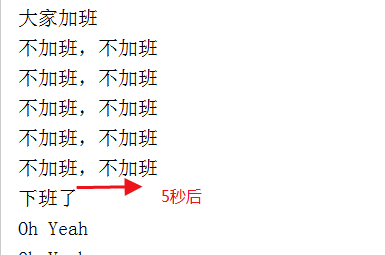
- # 信号量类似于停车场,一次只能处理n个线程
- # 1:导包
- import threading,time
- # 2:设置信号量
- semaphore = threading.Semaphore(5)
- # 3:创建线程对象
- class MyThread(threading.Thread):
- def run(self):
- if semaphore.acquire():
- print(self.name)
- time.sleep(3)
- semaphore.release()
- # 4:创建线程对象
- for i in range(0,20):
- t=MyThread()
- t.start()
信号量

- # 队列:多线程,线程安全
- # 1:引包
- import queue,time
- # 2:创建对象
- q=queue.Queue(3) #3表示队列的总容量为3、默认为先进先出类型
- # 3:常用的方法
- q.put("#3333") #添加数据
- q.put({"ab":"cd"})
- print(q.get()) #获取数据
- print(q.qsize()) #获取队列的长度
- print(q.empty()) #判断是否为空
- print(q.full()) #判断是否已满
- print(q.task_done()) #每对队列进行一次操作以后就会返回True
- print(q.join()) #task_done 对应的就是join
队列的常见属性
- # 通过队列,设置一个生产者消费者的开发模型
- # 1:引包
- import threading,queue,time,random
- # 2:定义队列
- que=queue.Queue()
- # 3:定义两个生产者、消费者的类
- def Producer(name):
- countBaoZi=1;
- while countBaoZi <= 10:
- # print("包子数量小于10,开始生产包子")
- time.sleep(random.randrange(1,3))
- que.put(countBaoZi)
- print("生产者:%s,生产了【包子%s】" % (name, countBaoZi))
- countBaoZi = countBaoZi + 1
- def Consumer(name):
- countBaoZi=1
- while countBaoZi<=10:
- time.sleep(random.randrange(1,4))
- if que.empty():
- print("老板没包子了")
- else:
- print("现在还有%s个包子" % que.qsize())
- curBaoZi = que.get()
- print("消费者:%s,吃了包子【%s】" % (name, curBaoZi))
- # 4:创建多个线程
- producerA = threading.Thread(target=Producer,args=("A大厨",))
- consumerA = threading.Thread(target=Consumer,args=("A君",))
- consumerB = threading.Thread(target=Consumer,args=("B君",))
- producerA.start()
- consumerA.start()
- consumerB.start()
队列-线程 生产者、消费者模式
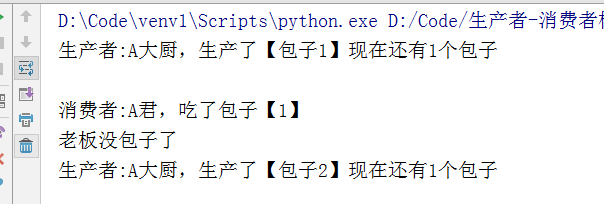
- # 通过队列,设置一个生产者消费者的开发模型
- # 升级版,包子吃了以后,还需要再去检查一下,有没有包子if que.empty() 这样浪费时间,
- # 应该是:吃完就告诉老板直接生产,生产好了再通知客户去吃
- # 1:引包
- import threading,queue,time,random
- # 2:定义队列
- que=queue.Queue()
- # 3:定义两个生产者、消费者的类
- def Producer(name):
- countBaoZi=1;
- while countBaoZi <= 10:
- time.sleep(random.randrange(1,3))
- que.put(countBaoZi)
- print("生产者:%s,生产了【包子%s】" % (name, countBaoZi))
- countBaoZi = countBaoZi + 1
- que.join()
- def Consumer(name):
- countBaoZi=1
- while countBaoZi<=10:
- time.sleep(random.randrange(1,4))
- print("现在还有%s个包子" % que.qsize())
- curBaoZi = que.get()
- time.sleep(1)
- print("消费者:%s,吃了包子【%s】" % (name, curBaoZi))
- que.task_done()
- # 4:创建多个线程
- producerA = threading.Thread(target=Producer,args=("A大厨",))
- consumerA = threading.Thread(target=Consumer,args=("A君",))
- consumerB = threading.Thread(target=Consumer,args=("B君",))
- producerA.start()
- consumerA.start()
- consumerB.start()
队列-线程 生产消费2

二 进程
- # 1:导包
- import time
- from multiprocessing import Process
- # 2:创建进程对象集合
- pros=[]
- # 3:定义方法
- def music(musicName):
- print("开始播放:%s.%s" %(musicName,time.ctime()))
- time.sleep(2)
- print("播放结束:%s.%s" %(musicName,time.ctime()))
- def play(gameName):
- print("开始打:%s.%s" %(gameName,time.ctime()))
- time.sleep(5)
- print("游戏结束:%s.%s" %(gameName,time.ctime()))
- if __name__ == '__main__':
- # 4:创建进行对象
- mu=Process(target=music,args=("My Heart Will Go On",))
- mu.start()
- mg=Process(target=play,args=("植物大战僵尸",))
- mg.start()
进程

- # 1:导包
- import time
- from multiprocessing import Process
- # 2:创建进程对象集合
- pros=[]
- # 3:定义方法
- def music(musicName):
- print("开始播放:%s.%s" %(musicName,time.ctime()))
- time.sleep(2)
- print("播放结束:%s.%s" %(musicName,time.ctime()))
- def play(gameName):
- print("开始打:%s.%s" %(gameName,time.ctime()))
- time.sleep(5)
- print("游戏结束:%s.%s" %(gameName,time.ctime()))
- if __name__ == '__main__':
- # 4:创建进行对象
- mu=Process(target=music,args=("My Heart Will Go On",))
- # 4.2:进程常用的属性和方法
- #mu.join() #进程阻塞
- mu.start() #开启进程
- time.sleep(1)
- mu.terminate() #结束进程
- print(" 进程名称 %s, 进程编码 %s,"%(mu.name,mu.pid))
常用的属性和方法

进程之间的三种通讯方法
进程队列
- # 1:导包
- from multiprocessing import Process,Queue
- import time
- #2:定义一个方法,用于向队列中赋值
- def putAction(q,n):
- q.put(n*(n+1))
- print("当前队列的id:",id(q))
- if __name__ == '__main__':
- # 3:创建一个队列
- que=Queue()
- print("main方法中队列的id:", id(que))
- # 4:通过循环创建多个进程
- for i in range(0,3):
- p=Process(target=putAction,args=(que,i,))
- p.start()
- print(que.get())
- print(que.get())
- print(que.get())
通过进程队列实现数据通信

- # 管道相当于生成两个连接对象,一个主进程使用,另外一个传递给子进程使用
- # 1:导包
- from multiprocessing import Process,Pipe
- import time
- # 2:定义函数
- def ConnAction(conn):
- # 获取传递过来的conn连接对象
- print("准备发送消息,时间%s"%(time.ctime()))
- conn.send("土豆土豆,我是地瓜,收到请回答")
- time.sleep(2)
- print("准备接收消息,时间%s"%(time.ctime()))
- responInfo = conn.recv()
- print(responInfo,time.ctime())
- if __name__ == '__main__':
- # 创建管道对象
- par_conn,child_conn=Pipe()
- # 创建进程
- p=Process(target=ConnAction,args=(child_conn,))
- p.start()
- print("主进程,准备接收消息,%s"%(time.ctime()))
- respons=par_conn.recv()
- print(respons,time.ctime())
- time.sleep(2)
- print("主进程,准备发送消息,%s"%(time.ctime()))
- par_conn.send("地瓜地瓜,我是土豆");
通过管道实现数据通信

- # 1:导包
- from multiprocessing import Process,Manager
- #2:定义方法
- def manaAction(d,l,n):
- # 对字典进行操作
- d[n]=""
- d[""]=2
- # 对列表进行操作
- l.append(n)
- if __name__ == '__main__':
- # 创建Manager对象中的数据类型
- with Manager() as manager:
- d=manager.dict()
- l=manager.list(range(5))
- p_list=[]
- # 创建进程
- for i in range(0,5):
- p=Process(target=manaAction,args=(d,l,i))
- p.start()
- p_list.append(p)
- for res in p_list:
- res.join()
- print(d)
- print(l)
通过Manager实现数据通信

- # 1:导入包
- from multiprocessing import Process,Lock
- import time
- #定义方法
- def printPro(l,n):
- with l:
- print("Hello,World %s,%s"%(n,time.ctime()))
- time.sleep(1)
- if __name__ == '__main__':
- l=Lock()
- for i in range(0, 5):
- p = Process(target=printPro, args=(l,i,))
- p.start()
进程锁

- # 1:导包
- from multiprocessing import Process,Pool
- import time
- # 3:创建方法
- def foo(i):
- time.sleep(1)
- print(i)
- return i
- # 4:创建回调方法
- def bar(arg):
- #回调方法在主函数中执行
- print("hello,%s"%arg)
- if __name__ == '__main__':
- # 2:创建进程池对象
- pool = Pool(5)
- for i in range(0,30):
- pool.apply_async(func=foo,args=(i,),callback=bar)
- pool.close()
- pool.join()
进程池
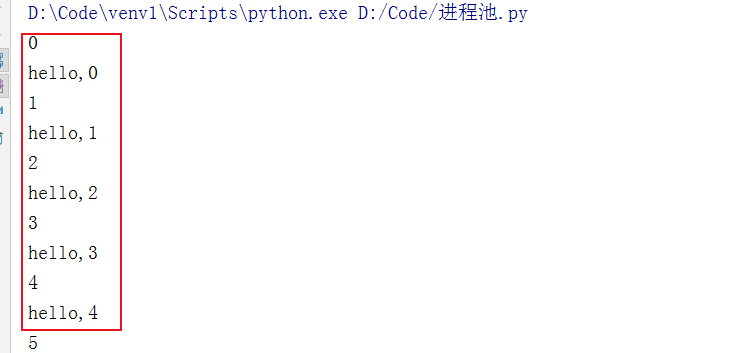
三 协程
协程是一种非抢占式程序,其本质是一个线程。
优点:1:灭有切换消耗;2:没有锁的概念
缺点:无法使用多核,但是可以通过多进程+协程弥补
- # 通过yield来实现
- # 1:导包
- import time
- #2:消费者
- def Consumer(name):
- print("准备开始吃包子")
- while True:
- newbaozi=yield
- print("%s吃了包子%s"%(name,newbaozi))
- #3:生产者
- def Product():
- r=con.__next__()
- r2=con2.__next__()
- baoziName=1
- while True:
- time.sleep(1)
- print("生产者,生产了%s和%s包子"%(baoziName,baoziName+1))
- con.send(baoziName)
- con2.send(baoziName+1)
- baoziName+=2
- #主方法
- if __name__ == '__main__':
- #创建两个用户
- con=Consumer("张三")
- con2=Consumer("李四")
- Product()
协程-yield
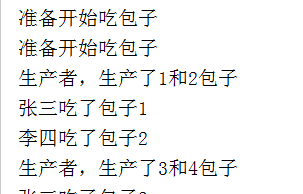
- from greenlet import greenlet
- def test1():
- print(12)
- gr2.switch()
- print(34)
- gr2.switch()
- def test2():
- print(56)
- gr1.switch()
- print(78)
- gr1 = greenlet(test1)
- gr2 = greenlet(test2)
- gr1.switch()
协程-greenlet

- # 1:导包
- import gevent
- import requests,time
- # 记录开始时间
- start = time.time()
- def f(url):
- # print("Get:%s" %url)
- reap=requests.get(url)
- data=reap.text
- print("%s网址上一共有%s字节"%(url,len(data)))
- gevent.joinall([
- gevent.spawn(f, 'https://www.python.org/'),
- gevent.spawn(f, 'https://www.yahoo.com/'),
- gevent.spawn(f, 'https://www.baidu.com/'),
- gevent.spawn(f, 'https://www.sina.com.cn/'),
- ])
- print("耗时",time.time()-start)
- f('https://www.python.org/')
- f('https://www.yahoo.com/')
- f('https://www.baidu.com/')
- f('https://www.sina.com.cn/')
- print("耗时",time.time()-start)
协程-gevent

饮冰三年-人工智能-Python-20 Python线程、进程、线程的更多相关文章
- 饮冰三年-人工智能-Python-22 Python初识Django
1:一个简单的web框架 # 导包 from wsgiref.simple_server import make_server #自定义个处理函数 def application(environ,st ...
- 饮冰三年-人工智能-Python-21 Python数据库MySql
一:下载与安装 1:下载地址:https://dev.mysql.com/downloads/mysql/ 2:安装MySql 打开下载文件解压到指定文件目录.(我这里解压目录为D:\MySql\my ...
- 饮冰三年-人工智能-Python-19 Python网络编程
Socket:套接字.作用:我们只需要安照socket的规定去编程,就不需要深入理解tcp/udp协议也可以实现 1:TCP协议 1.1 客户端服务端循环收发消息 # 1:引入stock模块(导包) ...
- 饮冰三年-人工智能-Python-10之C#与Python的对比
1:注释 C# 中 单行注释:// 多行注释:/**/ python 中 单行注释:# 多行注释:“““内容””” 2:字符串 C#中 "" 用双引号如("我是字符串&q ...
- 饮冰三年-人工智能-linux-08 软件包管理(Python的安装)
1:软件包存放的位置 media/CentOS_6.9_Final/Packages文件夹下 2.RPM就是Red Hat Package Manger(红帽软件包管理工具)的缩写. 2.1 常用的命 ...
- 饮冰三年-人工智能-Python-30 python开发中常见的错误
1:触发条件:创建的实体类生成到数据库表时报错 报错信息:TypeError: __init__() missing 1 required positional argument: 'on_delet ...
- 饮冰三年-人工智能-Python-23 Python PyCharm 使用中常见的问题
一:软件工具使用中遇到的问题 1:AttributeError: module 'pip' has no attribute 'main'问题 处理方法: a:找到JetBrains\PyCharm ...
- 饮冰三年-人工智能-Python-18Python面向对象
1 类与实例对方法和属性的修改 class Chinese: # 这是一个Chinese的类 #定义一个类属性,又称为静态数据或者静态变量,相当于C#中的static country="Ch ...
- 饮冰三年-人工智能-Python-25 Django admin
简介:一个关于后台数据库管理的工具 1:创建一个新的项目 2:设置models,并通过命令生成数据库表 from django.db import models class Book(models.M ...
随机推荐
- 2.6 datetime 模块
目录 2.6.1 常用类 2.6.1.1 datetime.date 2.6.1.2 datetime.time 2.6.1.3 datetime.datetime 2.6.1.4 datetime ...
- beego框架的最简单登入演示
一.controllers逻辑代码 func (c *UserController) Get() { c.TplName="login.html" } func (c *UserC ...
- [JDK8]读写锁的改进:StampedLock
StampedLock是Java8引入的一种新的锁机制,简单的理解,可以认为它是读写锁的一个改进版本,读写锁虽然分离了读和写的功能,使得读与读之间可以完全并发,但是读和写之间依然是冲突的,读锁会完全阻 ...
- 基于alpine制作php镜像
alpine包搜索https://pkgs.alpinelinux.org/ 安装依赖库 apk add --no-cache xxx 可以基于php apline镜像自行增加或删除扩展. https ...
- 第九节: 利用RemoteScheduler实现Sheduler的远程控制
一. RemoteScheduler远程控制 1. 背景: 在A服务器上部署了一个Scheduler,我们想在B服务器上控制这个Scheduler. 2. 猜想: A服务器上的Scheduler需要有 ...
- css选择器(常规选择器,伪类选择器,伪元素选择器,根元素选择器)
前言 CSS的一个核心特性是能向文档中的一组元素类型应用某些规则,本文将详细介绍CSS选择器 选择器 [通配选择器] 星号*代表通配选择器,可以与任何元素匹配 *{color: red;} [元素选择 ...
- python中的GIL详解
GIL是什么 首先需要明确的一点是GIL并不是Python的特性,它是在实现Python解析器(CPython)时所引入的一个概念.就好比C++是一套语言(语法)标准,但是可以用不同的编译器来编译成可 ...
- 用 Mathematica 获取图片的 RGB 三基色
ColorConvert[*, "RGB"] // InputForm 其中 * 表示你把你的图片拖入 Mathematica 中.
- Java8从对象列表中取出某个属性的列表
List<属性值类型> 属性List = 对象List.stream().map(对象::get方法()).collect(Collectors.toList()); 例如: List&l ...
- 在Windows上安装Arduino-IDE
Arduino IDE的官方下载地址为:http://arduino.cc/en/Main/Software 也可以从我的网盘下载:win系统 1.8.9版本 链接:https://pan.baidu ...
